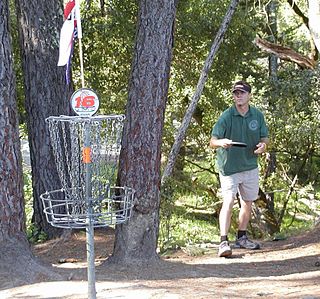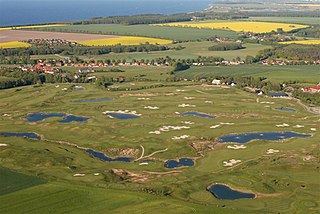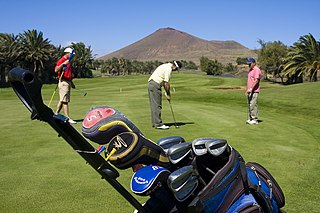
Disc golf, formerly known as frisbee golf, is a flying disc sport in which players throw a disc at a target; it is played using rules similar to golf. Most disc golf discs are made out of polypropylene plastic, otherwise known as polypropene, which is a thermoplastic polymer resin used in a wide variety of applications. Discs are also made using a variety of other plastic types that are heated and molded into individual discs. The sport is usually played on a course with 9 or 18 holes (baskets). Players complete a hole by throwing a disc from a tee pad or area toward a target, known as a basket, throwing again from where the previous throw landed, until the basket is reached. The baskets are formed by wire with hanging chains above the basket, designed to catch the incoming discs, which then fall into the basket. Usually, the number of throws a player uses to reach each basket is tallied, and players seek to complete each hole in the lowest number of total throws. Par is the number of strokes an expert player is expected to make for a given hole or a group of holes.

A golf course is the grounds on which the sport of golf is played. It consists of a series of holes, each consisting of a tee box, a fairway, the rough and other hazards, and a green with a cylindrical hole in the ground, known as a "cup". The cup holds a flagstick, known as a "pin". A standard round of golf consists of 18 holes, and as such most courses contain 18 distinct holes; however, there are many 9-hole courses and some that have holes with shared fairways or greens. There are also courses with a non-standard number of holes, such as 12 or 14.
The following is a glossary of the terminology currently used in the sport of golf. Where words in a sentence are also defined elsewhere in this article, they appear in italics. Old names for clubs can be found at Obsolete golf clubs.

The Professional Disc Golf Association (PDGA) is a 501(c)(4) nonprofit membership organization dedicated to the promotion and sustainable growth of disc golf. The PDGA is the global governing body of disc golf. The organization promotes the sport through tournament development, course development, rules and competitive standards, media and sponsor relations, and public education and outreach.

Sedgley Woods is a section of east Fairmount Park, Philadelphia, Pennsylvania, and a historical disc golf course site. The site was established in 1977. It has one of the oldest permanent pole-hole disc golf courses. Friends of Sedgley Woods, a volunteer organization, maintains the grounds, runs monthly tournaments, community outreach programs, and occasional events in conjunction with the Mid-Atlantic Disc Club and the Professional Disc Golf Association.

In golf, par is the predetermined number of strokes that a proficient golfer should require to complete a hole, a round, or a tournament. For scoring purposes, a golfer's number of strokes is compared with the par score to determine how much the golfer was either "over par", "under par", or was "even with/equal to par".

Flying disc sports are sports or games played with discs, often called by the trademarked name Frisbees. Ultimate and disc golf are sports with substantial international followings.

Golf equipment encompasses the various items that are used to play the sport of golf. Types of equipment include the golf ball, golf clubs, and devices that aid in the sport.
Tokyo Friend Park 2 is a Japanese game show that premiered in April 1994 on the Tokyo Broadcasting Station (TBS). TFP2 airs on Monday nights roughly from 6:55 - 7:54 JST in Japan.

Golf is a club-and-ball sport in which players use various clubs to hit a ball into a series of holes on a course in as few strokes as possible.

Innova Champion Discs Inc., generally known simply as Innova is an American disc golf brand and manufacturing company. Founded in 1983, it is the largest disc golf disc manufacturer and was among the first companies to produce equipment specifically for disc golf.
Disc Golf Association (DGA) is a company founded in 1976 by Ed Headrick and located in Watsonville, California. The Disc Golf Association | DGA, is the founding company of the sport of disc golf and was the acting overseeing body for the sport until the establishment of the Professional Disc Golf Association (PDGA). The PDGA was run by Ed Headrick and the DGA until 1982. They are a manufacturer of disc golf baskets for the sports of Disc Golf. The company does not have any retail stores, but rather sells disc golf courses to park departments, disc golf clubs, and private parties. The company also sells large quantities of discs and other related disc golf equipment to resalers and wholesalers around the world.
Paul McBeth is an American professional disc golfer from Huntington Beach, California. He won the PDGA World Championships four times in a row and again in 2019 and 2022, making him a six-time champion. He did not finish outside the top 2 at a World championship between 2012 and 2022. McBeth was the top rated player of the PDGA in 2015, 2017, 2018, and again in 2019. He is widely considered to be the best disc golfer of the modern era.

Ed Headrick, also known as "Steady" Ed Headrick, was an American toy inventor. Headrick served in combat in the army in WWII and was a deep-sea welder. He is most well known as the father of both the modern-day Frisbee and of the sport and game of disc golf.
Krokhol Disc Golf Course is a world-class 18-hole disc golf course located in Siggerud, Norway, 20 kilometres (12 mi) southeast of Oslo. Set on an abandoned ball golf course, it features long holes on hilly grass fairways lined with thick woods, and is widely considered the best disc golf course in Norway. The course is available to the public at no charge with an optional donation to help fund maintenance and future development.
Modern disc golf started in the early 1960s, but there is debate over who came up with the idea first. The consensus is that multiple groups of people played independently throughout the 1960s. Students at Rice University in Houston, Texas, for example, held tournaments with trees as targets as early as 1964, and in the early 1960s, players in Pendleton King Park in Augusta, Georgia would toss Frisbees into 50-gallon barrel trash cans designated as targets. In 1968 Frisbee Golf was also played in Alameda Park in Santa Barbara, California by teenagers in the Anacapa and Sola street areas. Gazebos, water fountains, lamp posts, and trees were all part of the course. This took place for several years and an Alameda Park collectors edition disc still exists, though rare, as few were made. Clifford Towne from this group went on to hold a National Time Aloft record.
Eagle Wynne McMahon is an American professional disc golfer from Boulder, Colorado, sponsored by Discmania Golf Discs. He has 53 career wins and has been one of the highest rated players in the world for several years. At the end of the 2022 season he was ranked third in the world by UDisc.

A basket is by far the most common type of target used in disc golf. It features a disc-catching basket under a deflection assembly generally made out of chain. Permanent baskets on courses are built on an anchored metal pole, but portable disc golf baskets with foldable mechanisms to facilitate transportation also exist.

The COVID-19 pandemic has caused disruption to disc golf across the world, mirroring its impact across all sports. Throughout the world and to varying degrees, leagues and competitions have been cancelled or postponed.

Kristin Tattar is an Estonian professional disc golfer and former competitive cross-country skier. Tattar is Estonia’s most successful disc golfer of all time, and in 2022 she achieved the highest PDGA rating of any Estonian female. In 2022 she became the female disc golf world champion for the first time.












